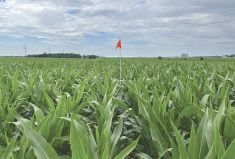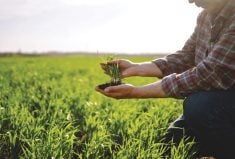Whether the problem was weeds, insects or diseases, for the past several decades the solution has usually been a chemical one. But with growing problems of resistance and customer opposition to chemicals, researchers and manufacturers are turning their attention to biological solutions.
It’s not as though biologicals are new. For decades, growers have been using inoculants derived from bacteria and fungi. But a new generation of biologicals may be set to arrive, including from established companies using existing synthetic technologies as a springboard into the market. The focus on biologicals has sharpened in the past five years and growth in the sector is expected to be 50 per cent in 2022.
It will still take time to see the products now in development being marketed to growers, yet Darren Anderson says he can’t help but be impressed by what he’s seeing.
Read Also

Could crop sharing be a viable option for your farm?
Crop sharing could be a good option for young and beginning farmers.
“There are some challenges that a lot of the biologicals-only businesses are going to have in terms of getting commercial traction and getting through the regulatory processes,” says Anderson, chief executive officer of Vive Crop Protection. “But with the amount of capital going into the space, there’s just no way it’s not going to have an enormous impact.”
Vive has six products on the market in the U.S., of which five are synthetics. The sixth is their first biological combined with a synthetic — both fungicides, with one based on azoxystrobin (the active ingredient in Quadris) and a plant extract, Renoutria sachalinensis.
“By using the two together, it creates a lot of advantages for growers because they have the benefit of multiple modes of action, the potential ability to deal with resistance challenges and reducing the amount of synthetic applied,” Anderson says. “From a grower perspective, they know what they’re going to get with the synthetic and they get the upside associated with the biological versus having a complete reliance on a solo product.”
He says there are more opportunities for combining biologicals with synthetics.
“There are some companies that are doing some really interesting things on the synthetic discovery side.That’s where I really see the potential coming in biologicals. The breadth of tools in the soil underneath a producer’s feet is incredible with respect to what those microbes can do, it’s just a question of getting the science right and getting the path to market right.”
Big opportunity
Another company that’s part of this landscape is A&L Biologicals, a division of A&L Canada Laboratories. The company has two biological soil diagnostic products on the market, with several more under development from a microbial library that includes more than 4,000 isolates that are screened for functional traits, then further classified as potential biocontrol or bio-fertilizer products. Like Anderson, Rob Field believes biologicals represent a huge opportunity for providing farmers with unique solutions to the challenges they’re facing.
“The sector’s experiencing exponential growth,” says Field, A&L’s vice-president of business development and marketing. “Sustainability and technology are the key drivers of growth alongside population growth and the need for more food.”

Despite a less-robust selection of products, particularly here in Canada, Field sees the amount of interest from investors and the resulting flow of capital as positive signs. What’s needed, however, is accuracy, not hype about the potential for biologicals.
“There’s a perception that biologicals are not as effective as conventional synthetic products,” he says. “For the most part, this is an inaccurate assessment that must be overcome with technology and industry promotion. Biological solutions are safer than synthetic solutions and provide a quicker path to registration.”
Field says public sentiment is a driving force affecting legislation in Europe, as are certain trends in food production. Demand for fruits and vegetables continues to grow as people recognize their health benefits, yet consumers perceive pesticide residues to be a critical food safety concern.
“There is unlimited potential in the biologicals sector,” says Field. “Issues like fungicide resistance provide opportunities for investment in biological solutions.”
A&L Biologicals and Vive Crop Protection are also working together on product development, with a relationship based on complementary strengths and common goals to develop new product technology. It’s an important collaboration that allows A&L Biologicals to align its microbial technology with Vive Crop Protection’s expertise in product development and market intelligence.
Good news, bad news
The good news is that it will be cheaper and quicker to develop biologicals. Anderson says it used to be said that it took 10 years and $100 million to get a new synthetic to market. That’s now estimated at 13 years and $300 million. For biologicals, those numbers will be much smaller.
“There are some challenges for biologicals — like scale-up, because they’re made in a similar way to brewing beer … the same issues apply with creating biological products. There are different challenges but it’s nowhere near the level of capital investment as with synthetics. It’s more like five years and $5 to $20 million to get a product ready to go, depending on what it is.”
The bad news is that while there’s a good outlook for biological insecticides, fungicides and fertility boosters, it’s not as bright for herbicides. From a technical perspective, it’s easier to find bugs to fight other bugs than to find bugs that are effective in dealing with weeds. It’s more likely that development of weed management products will come from plant extracts or RNAi research.
“Plants can actually emit extracts that prevent the colonization of other plants,” says Anderson. “If you could concentrate and bottle those, that’d be a huge opportunity, or bundling a fungus specific to a particular weed species. But we’ll see a bunch of really successful fungicides, insecticides and even nematicides before we see successful new herbicide technologies from biologicals.”
















